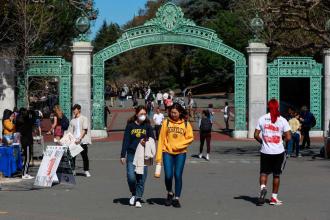The best college in America has been sitting quietly in the Bay Area, without that formal distinction, for 158 years.
But now UC Berkeley is officially the best, says Forbes magazine, which ranks colleges and placed the university in the No. 1 spot on its new list. UC Berkeley was the 13th best college in America in 2019, the last time the rankings came out.
A lot can change in two years.
After learning this month that it was a better college than Yale, the runner-up; Princeton in third place; and archrival Stanford in fourth, UC Berkeley issued a press release to express its elation in the manner of academics everywhere.
“It is gratifying,” university spokesperson Janet Gilmore said.
As a representative of the best college in America, Gilmore also made reference to UC Berkeley’s “world-class education,” and its “broad cross-section of exceptional students” and “transforming lives.”
The press release said the university was the first public university to win Forbes’ top ranking “if you count out West Point, a military academy, taking the top spot in 2009.”
So even if the East Bay’s public university actually is the second to be first, being first depends on who you ask.
US News & World Report, which also ranks colleges, says Princeton is the best college in America and that UC Berkeley trails at 22nd. The British college ranking company QS says MIT is tops in its list, with UC Berkeley in 32nd place.
Which all gets to what some higher education observers say is the difficulty with rankings in the first place: They are subjective.
“Subjectivity and bias cannot be completely removed from college rankings,” says Campus Explorer, a company that helps prospective students simplify the process of choosing a school. Its article, “The Pros and Cons of Using College Rankings,” concludes, “it is virtually impossible to rank colleges accurately and consistently.”
Forbes suspended its list in 2020 because of the pandemic. The company used the pause to tweak its criteria for judging colleges — a boon for UC Berkeley.
For the first time, the company gives weight to issues of particular concern to low-income students: six-year graduation rates of part-timers, transfer students and Pell grant recipients, as well as how many Pell recipients are enrolled, and how long it takes graduates — and, separately, lower-earning graduates — to pay off their student debt. Forbes calls the latter category “return on investment.”
UC Berkeley scored well in these categories. For example, 27% of its undergraduates receive federal Pell grants for low-income students. By contrast, at Harvard, the university people often think of when they imagine the best in the country, 12% of undergraduates are Pell recipients.
Harvard ranked seventh out of 600 universities on the Forbes list.
The company uses six other criteria to rank American colleges.
Forbes bases 15% of a college’s score on each: student debt, return on investment, graduation rate and the number of graduates receiving certain awards and recognition — including those who land on the magazine’s own lists of national leaders.
The company bases 10% on the college’s student retention rate and on the academic achievements of its graduates.
The ranking reserves the largest single share of weight, 20%, to alumni salaries. But that’s where things get tricky: Should prospective students assume those salaries are what they will earn if they attend those colleges?
UC Berkeley’s alumni salary is listed as an attractive $138,000.
But while the topic header calls this the “average early career salary,” an asterisk beside each college clarifies in fine print that it is, in fact, the “median salary for workers with 10 or more years of experience.”
“I think this is a design flaw,” said Christian Kreznar, an assistant editor at Forbes who wrote a piece explaining how the company arrives at its rankings. “It’s a labeling misnomer.”
Asked why the company doesn’t eliminate the discrepancy with an accurate header, Kreznar said, “We feel comfortable putting that 10-year marker as ‘early career.’” As to the conflict between identifying salary figures as both “averages” and “medians” — two different calculations — Kreznar called that a “minute technical point,” adding that “median is commonly used as average.”
Such flaws do little to inspire confidence in the high-stakes lists.
Eloy Ortiz Oakley, chancellor of the California community college system and a University of California regent who is temporarily serving as education adviser to President Biden, praised the changes to Forbes’ rankings. But he remains a critic of the rankings themselves.
“While the changes made to add more emphasis on Pell recipients is a good thing — which highlights universities like Cal that serve more low-income students — the rankings are still flawed,” he told The Chronicle.
Some rankings still include SAT and ACT scores, Oakley said. UC and dozens of colleges around the country have dropped those tests, believing that they favor admissions for wealthier applicants who can afford expensive test preparation.
Oakley said college rankings also measure alumni wealth and “say more about the number of students that a university rejects rather than how many students it admits.”
That’s a question that Meredith Davis, an emerita professor at North Carolina State University, raised in her 2016 article, “Can College Rankings Be Believed?” in the open access Journal of Innovation, Design and Economics.
The answer, of course, isn’t yes or no, as with most things in academia.
Graduation rates, for example, might be a factor of grade inflation rather than the quality of instruction, Davis said, adding that students should consider searching for their preferred characteristics of colleges from direct sources of information, such as the U.S. Department of Education’s College Scorecard site.
Rankings “are not fine-grained enough to guide a particular student’s choice,” she said. Yet, despite skepticism, the rankings are big business, she wrote, and “are here to stay.”
